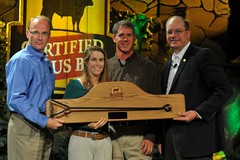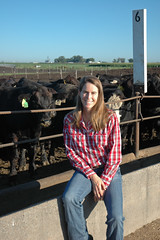Whenever life begins to transition toward a new path, there exists a series of “lasts”. Last week, I experienced the first of the lasts in the journey of shutting down the feed yard. Friday morning, I traveled south of Sumner, Nebraska to load up a group of yearlings at the Karlberg Ranch.
With the approach of fall, grass supplies diminish and feed yards in Nebraska begin the fall run of cattle as animals are gathered off of pastures and shipped to farms like mine.
A feed yard is pretty much like a hotel for cattle — A place where the animals go when seasonal limitations of grass resources require shipping off of the home ranch. The casserole of forage and grain that they receive on my farm enables them to continue to grow despite the fact that Mother Nature refuses to provide for about 7 months.

David and two of his three children — I got to watch these kids “grow up” while working with their dad.
David Karlberg and I have partnered raising beef for fifteen years. David cares for his cattle until they are 12-16 months old before sending them to my feed yard. The animals then make the short 30 mile trip from the ranch to my farm where they spend another four months preparing to make beef. Birth to harvest, the cattle spend their entire lives in Dawson County Nebraska.
Working with folks like David provides an integral part of my business model of collaboration. Tracing cattle performance, improving care over the animal’s lifetime, limiting animal stress, and searching for ways to improve quality in the end product: beef.
David and I became smarter together than we could have ever been alone.
Over the past 15 years, we have cared for and improved the lives of close to 6000 animals — producing more than 5 million pounds of beef and bovine products. Each one of you has benefited by our dedication and collaboration.
Friday morning provided the last time that I will bring David’s cattle (or any other new cattle) onto my farm. As we begin to exit the cattle feeding business, we will now stop bringing new cattle into the “hotel”. The 1835 animals already on my farm will remain with me until their time of shipment, but we will no longer “refill” the home pens with new animals after these cattle travel to Tyson.

An older Karlberg steer that shipped to Tyson today — more to come on “Benny” in the next post…
It was an emotional morning for me. Although I truly believe that it is time for a new journey, the reality of stepping away from what I have worked so hard to build weighs on me. There is regret and disappointment that I could not make my business model work as my management is a reflection of the values that make me Anne. I am thankful for David and my other ranchers who put time and energy into our partnerships – committing to search for ways to be better tomorrow than we are today.
I found my smile as I ended the day with a group of graduate students from the University of Nebraska @ Lincoln. The students visited the farm as part of the UNL Feed Yard Internship program which strives to prepare college graduates to be good cattle caregivers and businessmen/women. We had great discussions and I was very pleased that the professors and students felt that I had something meaningful to share. I have faith that some of them will work to continue the legacy that I have tried to foster 🙂




 Today, the animal care at my feed yard looks a lot different than it did that inaugural day in the summer of 1997. Incremental but significant change occurred over time as the focus on appropriate micros ensured an improvement for a macro concept. The dedication to the goal of improved welfare quite literally drove my career as a feed yard boss lady.
Today, the animal care at my feed yard looks a lot different than it did that inaugural day in the summer of 1997. Incremental but significant change occurred over time as the focus on appropriate micros ensured an improvement for a macro concept. The dedication to the goal of improved welfare quite literally drove my career as a feed yard boss lady.















